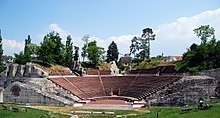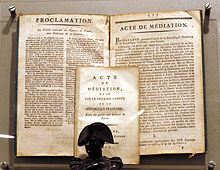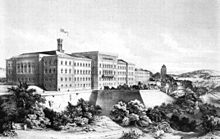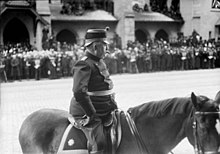Switzerland (/ˈswɪtsərlənd/; German: die Schweiz [ˈʃvaɪts];[note 3] French: la Suisse [sɥis(ə)]; Italian: la Svizzera [ˈzvittsera]; Romansh: la Svizra [ˈʒviːtsrɐ] or [ˈʒviːtsʁːɐ]),[note 4] officially the Swiss Confederation (Latin: Confoederatio Helvetica, hence its abbreviation CH), is a federal parliamentary republic consisting of 26 cantons, with Bern as the seat of the federal authorities, the so-called Bundesstadt("federal city").[1] The country is situated in Western and Central Europe,[note 5] where it is bordered by Italyto the south, France to the west, Germany to the north, and Austria and Liechtenstein to the east. Switzerland is a landlocked country geographically divided between the Alps, the Swiss Plateau and theJura, spanning an area of 41,285 km2 (15,940 sq mi). While the Alps occupy the greater part of the territory, the Swiss population of approximately 8 million people is concentrated mostly on the Plateau, where the largest cities are to be found; among them are the two global and economic centres of Zürich and Geneva.
The establishment of the Swiss Confederation is traditionally dated to 1 August 1291, which is celebrated annually as Swiss National Day. The country has a long history of armed neutrality—it has not been in a state of war internationally since 1815—and did not join the United Nations until 2002. Nevertheless it pursues an active foreign policy and is frequently involved in peace-building processes around the world.[9]In addition to being the birthplace of the Red Cross, Switzerland is home to numerous international organizations, including the second largest UN office. On the European level, it is a founding member of theEuropean Free Trade Association and is part of the Schengen Area – although it is notably not a member of the European Union, nor the European Economic Area.
Straddling the intersection of Germanic and Romance Europe, Switzerland comprises four main linguistic and cultural regions: German, French, Italian and Romansh. Therefore the Swiss, although predominantly German-speaking, do not form a nation in the sense of a common ethnicity or language; rather, Switzerland's strong sense of identity and community is founded on a common historical background, shared values such as federalism and direct democracy,[10] and Alpine symbolism.[11]
Switzerland ranks high in several metrics of national performance, including government transparency, civil liberties, economic competitiveness, and human development. It has the highest nominal wealth per adult (financial and non-financial assets) in the world according to Credit Suisse and the eighth-highest per capitagross domestic product on the IMF list.[12][13] Swiss citizens have the second-highest life expectancy in the world. Zürich and Geneva each have been ranked among the top cities with the highest quality of life in the world (the former coming second globally according to Mercer).[14]
Contents
[show]Etymology[edit]
Main article: Name of Switzerland
The English name Switzerland is a compound containing Switzer, an obsolete term for the Swiss, which was in use during the 16th to 19th centuries.[15] The English adjective Swiss is a loan from French Suisse, also in use since the 16th century. The name Switzer is from the Alemannic Schwiizer, in origin an inhabitant ofSchwyz and its associated territory, one of the Waldstätten cantons which formed the nucleus of the Old Swiss Confederacy. The name originates as an exonym, applied pars pro toto to the troops of the Confederacy. The Swiss began to adopt the name for themselves after the Swabian War of 1499, used alongside the term for "Confederates", Eidgenossen (literally: comrades by oath), used since the 14th century.
The toponym Schwyz itself is first attested in 972, as Old High German Suittes, ultimately perhaps related tosuedan "to burn", referring to the area of forest that was burned and cleared to build.[16] The name was extended to the area dominated by the canton, and after the Swabian War of 1499 gradually came to be used for the entire Confederation.[17][18] The Swiss German name of the country, Schwiiz, is homophonous to that of the canton and the settlement, but distinguished by the use of the definite article (d'Schwiiz for the Confederation,[19] but simply Schwyz for the canton and the town).[20]
The Latin name Confoederatio Helvetica was neologized and introduced gradually after the formation of the federal state in 1848, harking back to the Napoleonic Helvetic Republic, appearing on coins from 1879, inscribed on the Federal Palace in 1902 and after 1948 used in the official seal.[21] It is derived from the name of the Helvetii, a Gaulish tribe living on the Swiss plateau before the Roman era. Helvetia appears as a national personification of the Swiss confederacy in the 17th century, with a 1672 play by Johann Caspar Weissenbach.[22]
History[edit]
Main article: History of Switzerland
Switzerland has existed as a state in its present form since the adoption of the Swiss Federal Constitution in 1848. The precursors of Switzerland established a protective alliance at the end of the 13th century (1291), forming a loose confederation of states which persisted for centuries.
Early history[edit]
Main articles: Early history of Switzerland and Switzerland in the Roman era
The oldest traces of hominid existence in Switzerland date back about 150,000 years.[23] The oldest known farming settlements in Switzerland, which were found at Gächlingen, have been dated to around 5300 BC.[23]
The earliest known cultural tribes of the area were members of theHallstatt and La Tène cultures, named after the archaeological site of La Tène on the north side of Lake Neuchâtel. La Tène culture developed and flourished during the late Iron Age from around 450 BC,[23] possibly under some influence from the Greek and Etruscancivilisations. One of the most important tribal groups in the Swiss region was the Helvetii. Steadily harassed by the Germans, in 58 BC the Helvetii decided to abandon the Swiss plateau and migrate to western Gallia, but Julius Caesar's armies pursued and defeated them at the Battle of Bibracte, in today's western France, forcing the tribe to move back to its original homeland.[23] In 15 BC,Tiberius, who was destined to be the second Roman emperor and his brother, Drusus, conquered the Alps, integrating them into the Roman Empire. The area occupied by the Helvetii—the namesakes of the later Confoederatio Helvetica—first became part of Rome's Gallia Belgica province and then of its Germania Superior province, while the eastern portion of modern Switzerland was integrated into theRoman province of Raetia. Sometime around the start of the Common Era, the Romans maintained a large legionary camp called Vindonissa, now a ruin at the confluence of the Aare and Reuss rivers, near the town of Windisch, an outskirt of Brugg.
The first and second century AD were an age of prosperity for the population living along the Swiss plateau. Several towns, like Aventicum, Iulia Equestris and Augusta Raurica, reached a remarkable size, while hundreds of agricultural estates (Villae rusticae) were founded in the countryside.
In about 260 AD, the fall of the Agri Decumates territory north of the Rhine transformed today's Switzerland into a frontier land of the Empire. Repeated raids by theAlamanni tribes provoked the ruin of the Roman towns and economy, forcing the population to find shelter near Roman fortresses, like the Castrum Rauracense near Augusta Raurica. The Empire built another line of defense at the north border (the so-called Donau-Iller-Rhine-Limes), but at the end of the fourth century the increased Germanic pressure forced the Romans to abandon the linear defence concept, and the Swiss plateau was finally open to the settlement of German tribes.
In the Early Middle Ages, from the end of the 4th century, the western extent of modern-day Switzerland was part of the territory of the Kings of the Burgundians. TheAlemanni settled the Swiss plateau in the 5th century and the valleys of the Alps in the 8th century, forming Alemannia. Modern-day Switzerland was therefore then divided between the kingdoms of Alemannia and Burgundy.[23] The entire region became part of the expanding Frankish Empire in the 6th century, following Clovis I's victory over the Alemanni at Tolbiac in 504 AD, and later Frankish domination of the Burgundians.[25][26]
Throughout the rest of the 6th, 7th and 8th centuries the Swiss regions continued under Frankish hegemony (Merovingian and Carolingian dynasties). But after its extension under Charlemagne, the Frankish empire was divided by the Treaty of Verdun in 843.[23] The territories of present day Switzerland became divided intoMiddle Francia and East Francia until they were reunified under the Holy Roman Empire around 1000 AD.[23]
By 1200, the Swiss plateau comprised the dominions of the houses of Savoy, Zähringer, Habsburg, and Kyburg.[23] Some regions (Uri, Schwyz, Unterwalden, later known as Waldstätten) were accorded the Imperial immediacy to grant the empire direct control over the mountain passes. With the extinction of its male line in 1263 the Kyburg dynasty fell in AD 1264; then the Habsburgs under King Rudolph I (Holy Roman Emperor in 1273) laid claim to the Kyburg lands and annexed them extending their territory to the eastern Swiss plateau.[25]
Old Swiss Confederacy[edit]
Main article: Old Swiss Confederacy
Further information: Growth of the Old Swiss Confederacy, Reformation in Switzerland and Early Modern Switzerland
The Old Swiss Confederacy was an alliance among the valley communities of the central Alps. The Confederacy facilitated management of common interests and ensured peace on the important mountain trade routes. The Federal Charter of 1291agreed between the rural communes of Uri, Schwyz, and Unterwalden is considered the confederacy's founding document, even though similar alliances are likely to have existed decades earlier.[27][28]
By 1353, the three original cantons had joined with the cantons of Glarus andZug and the Lucerne, Zürich and Bern city states to form the "Old Confederacy" of eight states that existed until the end of the 15th century. The expansion led to increased power and wealth for the federation.[28] By 1460, the confederates controlled most of the territory south and west of the Rhine to the Alps and the Jura mountains, particularly after victories against the Habsburgs (Battle of Sempach, Battle of Näfels), over Charles the Bold ofBurgundy during the 1470s, and the success of the Swiss mercenaries. The Swiss victory in the Swabian War against the Swabian League of Emperor Maximilian I in 1499 amounted to de factoindependence within the Holy Roman Empire.[28]
The Old Swiss Confederacy had acquired a reputation of invincibility during these earlier wars, but expansion of the federation suffered a setback in 1515 with the Swiss defeat in the Battle of Marignano. This ended the so-called "heroic" epoch of Swiss history.[28] The success of Zwingli's Reformation in some cantons led to inter-cantonal religious conflicts in 1529 and 1531 (Wars of Kappel). It was not until more than one hundred years after these internal wars that, in 1648, under the Peace of Westphalia, European countries recognized Switzerland's independence from the Holy Roman Empire and its neutrality.[25][26]
During the Early Modern period of Swiss history, the growing authoritarianism of the patriciate families combined with a financial crisis in the wake of the Thirty Years' War led to the Swiss peasant war of 1653. In the background to this struggle, the conflict between Catholic and Protestant cantons persisted, erupting in further violence at the Battles of Villmergen in 1656 and 1712.[28]
Napoleonic era[edit]
In 1798, the revolutionary French government conquered Switzerland and imposed a new unified constitution.[28] This centralised the government of the country, effectively abolishing the cantons: moreover, Mülhausen joined France andValtellina valley, the Cisalpine Republic, separating from Switzerland. The new regime, known as the Helvetic Republic, was highly unpopular. It had been imposed by a foreign invading army and destroyed centuries of tradition, making Switzerland nothing more than a French satellite state. The fierce French suppression of the Nidwalden Revolt in September 1798 was an example of the oppressive presence of the French Army and the local population's resistance to the occupation.
When war broke out between France and its rivals, Russian and Austrian forces invaded Switzerland. The Swiss refused to fight alongside the French in the name of the Helvetic Republic. In 1803 Napoleon organised a meeting of the leading Swiss politicians from both sides in Paris. The result was the Act of Mediation which largely restored Swiss autonomy and introduced a Confederation of 19 cantons.[28] Henceforth, much of Swiss politics would concern balancing the cantons' tradition of self-rule with the need for a central government.
In 1815 the Congress of Vienna fully re-established Swiss independence and the European powers agreed to permanently recognise Swiss neutrality.[25][26][28] Swiss troops still served foreign governments until 1860 when they fought in the Siege of Gaeta. The treaty also allowed Switzerland to increase its territory, with the admission of the cantons of Valais, Neuchâtel and Geneva. Switzerland's borders have not changed since, except some minor adjustments.[29]
Federal state[edit]
Main articles: Restoration and Regeneration (Switzerland) and Switzerland as a federal state
The restoration of the power to the patriciate was only temporary. After a period of unrest with repeated violent clashes such as the Züriputsch of 1839, civil war (the Sonderbundskrieg) broke out in 1847 when some Catholic cantons tried to set up a separate alliance (the Sonderbund).[28] The war lasted for less than a month, causing fewer than 100 casualties, most of which were through friendly fire. However minor the Sonderbundskrieg seems to be when compared with other European riots and wars in the 19th century, it nevertheless had a major impact on both the psychology and the society of the Swiss and of Switzerland.
The war convinced most Swiss of the need for unity and strength towards its European neighbours. Swiss people from all strata of society, whether Catholic or Protestant, from the liberal or conservative current, realised that the cantons would profit more if their economic and religious interests were merged.
Thus, while the rest of Europe saw revolutionary uprisings, the Swiss drew up a constitution which provided for a federal layout, much of it inspired by the American example. This constitution provided for a central authority while leaving the cantons the right to self-government on local issues. Giving credit to those who favoured the power of the cantons (the Sonderbund Kantone), the national assembly was divided between an upper house (the Swiss Council of States, 2 representatives per canton) and a lower house (the National Council of Switzerland, representatives elected from across the country). Referenda were made mandatory for any amendment of this constitution.[26]
A system of single weights and measures was introduced and in 1850 the Swiss franc became the Swiss single currency. Article 11 of the constitution forbade sending troops to serve abroad, though the Swiss were still obliged to serve Francis II of the Two Sicilies with Swiss Guards present at the Siege of Gaeta in 1860, marking the end of foreign service.
An important clause of the constitution was that it could be re-written completely if this was deemed necessary, thus enabling it to evolve as a whole rather than being modified one amendment at a time.[32]
This need soon proved itself when the rise in population and the Industrial Revolution that followed led to calls to modify the constitution accordingly. An early draft was rejected by the population in 1872 but modifications led to its acceptance in 1874.[28] It introduced the facultative referendum for laws at the federal level. It also established federal responsibility for defense, trade, and legal matters.
In 1891, the constitution was revised with unusually strong elements of direct democracy, which remain unique even today.[28]
Modern history[edit]
Main articles: Switzerland during the World Wars and Modern history of Switzerland
Switzerland was not invaded during either of the world wars. During World War I, Switzerland was home to Vladimir Illych Ulyanov (Vladimir Lenin) and he remained there until 1917.[33] Swiss neutrality was seriously questioned by the Grimm–Hoffmann Affair in 1917, but it was short-lived. In 1920, Switzerland joined the League of Nations, which was based inGeneva, on the condition that it was exempt from any military requirements.
During World War II, detailed invasion plans were drawn up by the Germans,[34] but Switzerland was never attacked.[28]Switzerland was able to remain independent through a combination of military deterrence, concessions to Germany, and good fortune as larger events during the war delayed an invasion.[26][35] Under General Henri Guisan central command, a general mobilisation of the armed forces was ordered. The Swiss military strategy was changed from one of static defence at the borders to protect the economic heartland, to one of organised long-term attrition and withdrawal to strong, well-stockpiled positions high in the Alps known as the Reduit. Switzerland was an important base for espionage by both sides in the conflict and often mediated communications between the Axis and Allied powers.[35]
Switzerland's trade was blockaded by both the Allies and by the Axis. Economic cooperation and extension of credit to the Third Reich varied according to the perceived likelihood of invasion and the availability of other trading partners. Concessions reached a peak after a crucial rail link through Vichy France was severed in 1942, leaving Switzerland completely surrounded by the Axis. Over the course of the war, Switzerland interned over 300,000 refugees[36] and the International Red Cross, based in Geneva, played an important part during the conflict. Strict immigration and asylum policies as well as the financial relationships with Nazi Germany raised controversy, but not until the end of the 20th century.[37]
During the war, the Swiss Air Force engaged aircraft of both sides, shooting down 11 intruding Luftwaffe planes in May and June 1940, then forcing down other intruders after a change of policy following threats from Germany. Over 100 Allied bombers and their crews were interned during the war. During 1944–45, Allied bombers mistakenly bombed a few places in Switzerland, among which were the cities of Schaffhausen, Basel and Zürich.[35]
After the war, the Swiss government exported credits through the charitable fund known as the Schweizerspende and also donated to the Marshall Plan to help Europe's recovery, efforts that ultimately benefited the Swiss economy.[38]
During the Cold War, Swiss authorities considered the construction of a Swiss nuclear bomb.[39] Leading nuclear physicists at the Federal Institute of Technology Zurich such as Paul Scherrer made this a realistic possibility. However, financial problems with the defense budget prevented the substantial funds from being allocated, and the Nuclear Non-Proliferation Treaty of 1968 was seen as a valid alternative. All remaining plans for building nuclear weapons were dropped by 1988.[40]








No comments:
Post a Comment